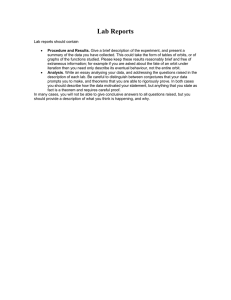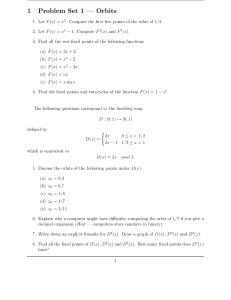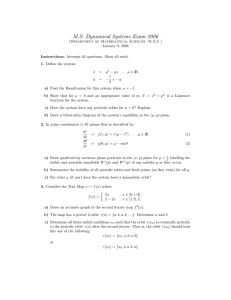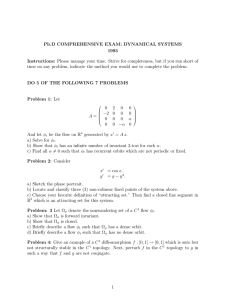ASSIGNMENT WEEK 5
advertisement
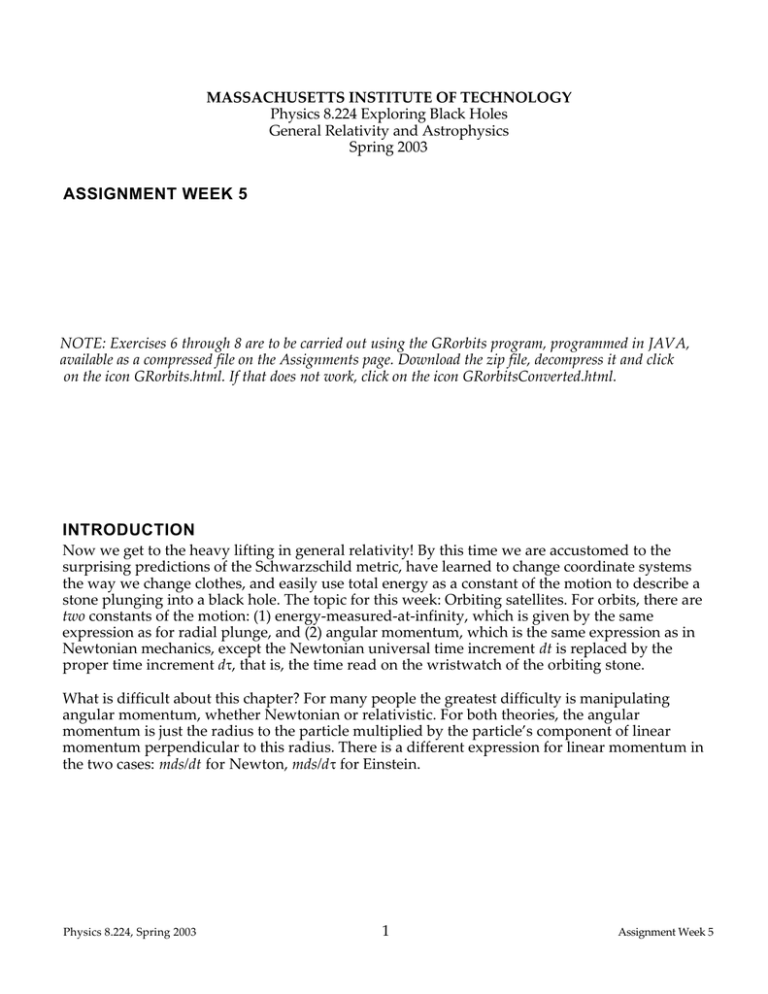
MASSACHUSETTS INSTITUTE OF TECHNOLOGY Physics 8.224 Exploring Black Holes General Relativity and Astrophysics Spring 2003 ASSIGNMENT WEEK 5 NOTE: Exercises 6 through 8 are to be carried out using the GRorbits program, programmed in JAVA, available as a compressed file on the Assignments page. Download the zip file, decompress it and click on the icon GRorbits.html. If that does not work, click on the icon GRorbitsConverted.html. INTRODUCTION Now we get to the heavy lifting in general relativity! By this time we are accustomed to the surprising predictions of the Schwarzschild metric, have learned to change coordinate systems the way we change clothes, and easily use total energy as a constant of the motion to describe a stone plunging into a black hole. The topic for this week: Orbiting satellites. For orbits, there are two constants of the motion: (1) energy-measured-at-infinity, which is given by the same expression as for radial plunge, and (2) angular momentum, which is the same expression as in Newtonian mechanics, except the Newtonian universal time increment dt is replaced by the proper time increment dτ, that is, the time read on the wristwatch of the orbiting stone. What is difficult about this chapter? For many people the greatest difficulty is manipulating angular momentum, whether Newtonian or relativistic. For both theories, the angular momentum is just the radius to the particle multiplied by the particle’s component of linear momentum perpendicular to this radius. There is a different expression for linear momentum in the two cases: mds/dt for Newton, mds/dτ for Einstein. Physics 8.224, Spring 2003 1 Assignment Week 5 The chapter on orbits ends by extending the idea of effective potential in Newtonian orbital mechanics to orbits in Schwarzschild spacetime. Why bother with effective potential? Because it gives an immediate qualitative view of the motion. From a graph derived from the energy and angular momentum of an unpowered spaceship, you can tell at a glance whether that spaceship and its crew will orbit the black hole, escape to infinite distance, or plunge through the horizon to oblivion. The effective potential offers a qualitative description of the orbit before the computer delivers a computer plot that may be wrong because of some misconception or programming error. A software program GRorbits by Slavomir Tuleja animates the effective potential analysis of orbits and delivers both qualitative analysis and numerical results. A neutron star is the most compact stellar object short of a black hole. Once the neutron star was identified, the question was inevitable: Is the formation of a black hole compulsory as more and more mass is added to a neutron star? Thorne describes the engagement of this question by the Big Guns: Zwicky, Landau, Oppenheimer, and finally the co-author of our text, Wheeler. So is implosion to a black hole compulsory? At the end of Thorne’s Chapter 5, Oppenheimer says yes, but at that time Wheeler remained unconvinced. READINGS Exploring Black Holes: Chapter 4, Orbiting AND Thorne, Chapter 5. Implosion is Compulsory AND Sections 3-5 of the notes "How Gravitational Forces Arise from Curvature" RECITATION The recitation quiz will include at least one of the following questions. 1. Why does the derivation for the energy of a radial plunger (EBH Chapter 3) lead to the same expression as the derivation for the energy of an orbiter (EBH Chapter 3)? 2. Given (a) a graph showing either the Newtonian or relativistic effective potential as a function of radius and (b) the energy of a particle on that graph, describe the orbit of the particle qualitatively. At what radii does the radial component of velocity increase or decrease? Will the orbit be bounded? Where does the particle reverse radial motion? Can the particle end up at infinity (and if so, at rest or in motion)? Will the particle plunge through the horizon? 3. Compare and contrast (a) the physical arguments that led Chandrasekhar to conclude that a white dwarf has a maximum mass of about 1.4 solar mass and (b) the physical arguments that led Oppenheimer and Volkoff to conclude that a neutron star has a maximum mass of between 0.5 and several times the solar mass. 4. Wheeler and Wakano studied cold, dead objects. Why cold and dead rather than hot and evolving? PROJECT By end of week #5 assignments will be made to project teams. Physics 8.224, Spring 2003 2 Assignment Week 5 HOMEWORK EXERCISES EXERCISE 1. CIRCULAR ORBIT This exercise asks you to use the results of derivations in the exercises of Chapter 4 of Exploring BHs to calculate some numerical results for the circular orbit of radius, r = 8M. Pay special attention to Exercises 2, 3, and 7 in the text. You are NOT asked to carry out the derivations in these exercises, but please cite the equations you use. Give all speeds as fractions of the speed of light. A What is the speed vbkkpr with which the Schwarzschild bookkeeper reckons the orbiter to be moving in circular orbit at r = 8M? What is the bookkeeper time for the completion of one orbit? B What is the speed of the stone vshell as measured by the shell observer at r = 8M ? What is the shell time for the completion of one orbit? C What is the speed vorbiter with which the orbiter at r = 8M measures the shell to be moving past her? What is the orbiter wristwatch time for the completion of one orbit? D Time travel. What is the time stretch factor dτ/dt for an astronaut in this orbit from the point of view of a far-away observer. What rocket speed in flat spacetime gives the same time stretch value? EXERCISE 2. NEWTONIAN ORBITS AS A LIMITING CASE Carry out Exercise 4, page 4-30 of EBH. EXERCISE 3. SCHWARZSCHILD ORBITS WITH HIGH ANGULAR MOMENTUM Make qualitative analyses of orbits around a black hole for the case of large angular momentum using the following outline. Simplify algebraic manipulations in this exercise by using dimensionless asterisked variables r*, L*, and V* introduced in Exercise 2, page 4-29 of EBH. Add E* = E/m to these definitions. You may use the results of any exercise in Chapter 4 without derivation, but cite the equations you use. A What is the form of equation [31] in dimensionless variables? 2 IN THE FOLLOWING ASSUME THAT L* >> 1 but in the resulting approximations keep 2 terms proportional to 1/L* . HINT: See approximation inside back cover of EBH. B What is the minimum radius r*minV and the maximum radius r*maxV of a circular orbit at the minimum and maximum of the squared effective potential V* 2 2 2 C What are the values of V* min and V* max? Physics 8.224, Spring 2003 3 Assignment Week 5 2 D For what value of E* will the orbit be circular and stable. 2 E For what range of E* will the orbit be bound between two fixed values of r? 2 F For what range of E* will the particle ALWAYS escape to infinity? 2 G For what value of E* will the orbit be circular and unstable? EXERCISE 4. TIME TO THE CENTER FROM ANY INITIAL RADIUS. A An astronaut falls from rest at an initial radius ro outside the horizon. How long does it take her to reach the center as recorded on her wristwatch? B For ro = 8M, what is the numerical value of the wristwatch time to the center, expressed as a multiple of M (meters). What is this wristwatch time in seconds for the black hole at the center of our galaxy, whose mass is approximately 2.6 million times the mass of Sun? Assume (incorrectly) that this black hole is not spinning. EXERCISE 5. FALLING IN THE RAIN. The Schwarzschild metric is only one possible representation of the spacetime of a non-spinning black hole. Project B of EBH, and the supplementary notes Gravity, Metrics, and Coordinates, present another form of the metric using rain coordinates. A Starting from equation (21) of Gravity, Metrics, and Coordinates (but setting G=1), use the EulerLagrange equations of the notes How Gravitational Forces arise from Curvature to derive expressions for E/m and L/m, the conserved energy at infinity and angular momentum per unit mass. (Hint: repeat the derivations of equations 21-26 of the latter notes.) Your results will differ slightly from equations (28) of the notes How Gravitational Forces arise from Curvature. Why? B Consider a radially falling test mass, for which L=0. Using the rain-frame metric – equation (21) of Gravity, Metrics, and Coordinates – and your result for E/m in part A, eliminate dr/dτ and show that the rain-frame bookkeeper time and wristwatch time are related by a “clock rate” dt/dτ given by a solution of the following quadratic equation: 2M dt 2 E dt 2M E 2 1 − − 2 + + 2= 0 m d r r d m The quadratic has two roots. Give the root corresponding to infall, dr/dτ < 0. C Using the results of this exercise, show that a body that falls from rest at an initial radius ro outside the horizon has 1/ 2 E 2M = 1 − m ro Physics 8.224, Spring 2003 4 Assignment Week 5 Using this and the result of part B, show that as the body crosses the horizon, dt/dτ remains finite in rain coordinates. When viewed by a rain-frame bookkeeper, can a body ever cross the horizon? How about when viewed by a Schwarzschild-frame bookkeeper? EXERCISES WITH GRorbits PROGRAM Download the compressed Java Orbits program from the Materials section of the website and expand the file. Click on the icon GRorbits.html. If that does not work, click on the icon GRorbitsConverted.html. PLAY AROUND with the various controls and Menu settings. Pay attention to Schwarzschild coordinates, rain coordinates, and Newtonian predictions. EXERCISE 6. FALLING FROM REST AT ro = 8M . A plunger falls from rest starting at ro = 8M . Use the orbits program to determine how long it takes to reach the singularity. On whose clock is this time recorded? Compare the GRorbits result with the prediction you derived in Exercise 4. HINT: You have to use rain coordinates, because the plunger does not pass through the horizon as clocked by the Schwarzschild bookkeeper. EXERCISE 7. CIRCULAR ORBIT AT ro = 8M Choose a circular orbit with r = 8M (same as exercises 1). Compare the values of the periods of this orbit for bookkeeper and wristwatch (orbiter) that you predicted in exercise 1 with that you observe using the GRorbits program. HINT: Make liberal use of the "Set stable circular orbit" command under the INITIAL menu item. EXERCISE 8. ADVANCE OF THE PERIASTRON Select ZOOM X100 from the menu at the top of the display. Find values of the parameters of a bounded orbit so that the periastron advances 20 degrees per orbit. (Perigee for orbit around Earth; perihelion for orbit around Sun, periastron for orbit around a star or a black hole.) Is it possible for you to find such parameters for orbits predicted by Newton? Physics 8.224, Spring 2003 5 Assignment Week 5
